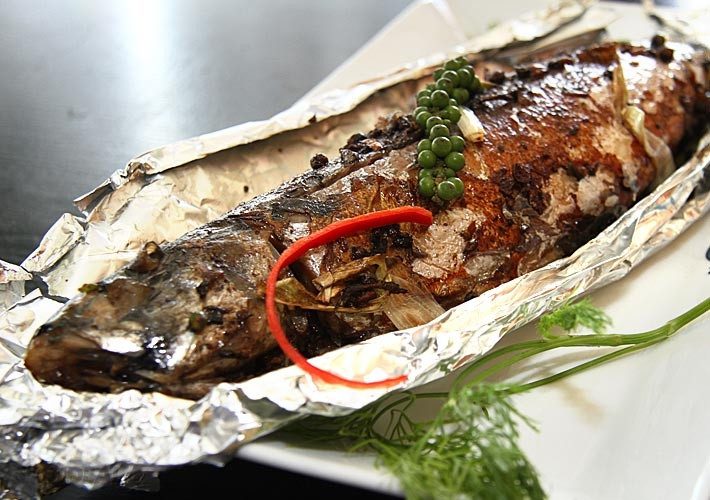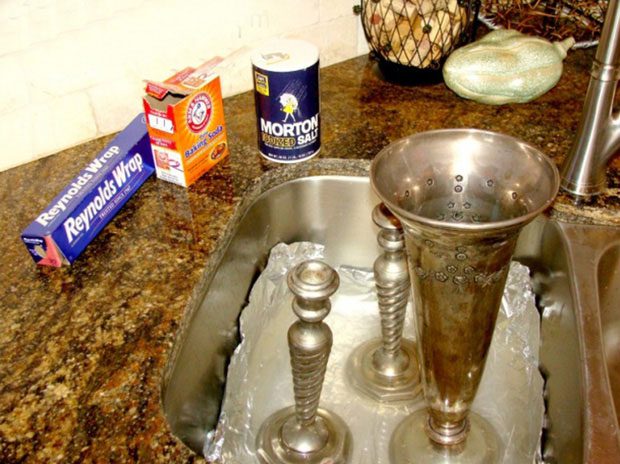At high temperatures, the aluminum in food wrapping foil can dissolve into food, subsequently entering the body and affecting health.
Understanding Aluminum Foil
What is Aluminum Foil?
Aluminum foil, also known as foil paper, is very lightweight, thin, and versatile. This type of foil is made from a metal component that can easily be shaped, wrapped, packaged, covered, or lined underneath when cooking and storing food.
Aluminum foil is produced with an ultra-thin paper surface measuring 30×10, and its toughness makes it easy to use when bending. This is the most common and popular type of aluminum foil.

Aluminum foil is very useful in many situations such as grilling and food storage…
How to Use Aluminum Foil
Aluminum foil is a product that almost everyone knows or has used at least once. It is widely used in the food service industry, especially in preparing delicious grilled dishes such as fish and meat.
Aluminum foil is very useful in many situations such as grilling, food storage, and shaping dishes. Using aluminum foil is simple; just wrap the food with the foil or cover the grilling tray. The food will cook slowly, thoroughly, without losing moisture or flavor, and it won’t burn. Lining the baking tray with foil helps baked goods become crispier and evenly golden while preventing the baking surface from drying out or cracking and allowing for desired shapes.
Using aluminum foil to cool and store food in the refrigerator prevents air from entering, keeping the food from drying out, protecting against oxidation, preserving flavor, and preventing freezing.
Additionally, aluminum foil is commonly used in nail services. It is a tool in the nail technician’s toolkit, widely used for wrapping, removing gel, and acrylic nail surfaces. When you want to remove gel polish after a period of wearing it, you will use aluminum foil combined with a removal solution. The foil helps to generate heat, keeping warmth and speeding up the process of breaking down the gel or acrylic layers.
If bubble wrap and shaped foam are used alongside other products including cardboard boxes, PE bags, shrink wrap, desiccants, aluminum foil, paper pallets, corner braces, strapping tape, and adhesive tape to protect products during transportation or safe storage, aluminum foil is an essential tool for preservation and food preparation for homemakers.
Uses of Aluminum Foil
- 1. A Temporary Funnel for Pouring Liquids: If you want to pour water into a bottle without spilling, either you need a funnel, or you can use aluminum foil as a substitute.

- 2. Double-Sided Clothing: Simply place a piece of aluminum foil inside your clothing, and it will allow you to iron both sides at once since aluminum foil conducts heat quickly to the other side.
- 3. Sharpen Scissors: When your scissors become dull, cut through a piece of aluminum foil about 10 times. This will sharpen the scissors by removing rust and debris stuck on the blades.
- 4. Extend Battery Life: If your battery is running low and you don’t have a new one, crumple a piece of aluminum foil and place it in the contact point to boost the battery’s energy.
- 5. Remove Static from Clothes: Toss a ball of aluminum foil into the washing machine along with your clothes. This ball will help eliminate static, dust, and hair.
- 6. Clean an Iron’s Surface: If the surface of your iron is rusty or burnt, you can use aluminum foil to clean it.
- 7. Support Cleaning Silverware: To clean silverware, place a layer of aluminum foil at the bottom of a dish. Then, add some baking soda, salt, and boiling water, and soak for about 15 minutes.

- 8. Boost Wi-Fi Signal at Home: Fold a sheet of aluminum foil several times and place it behind your antenna like a reflector. This will enhance your Wi-Fi signal.
- 9. Prevent Sticking While Frying: To avoid food sticking to the pan while frying, place a layer of aluminum foil over the bottom of the pan before cooking. This method can be done without using any cooking oil.
- 10. Remove Rust from Metal Surfaces: After crumpling aluminum foil into a ball, you can use it to scrub metal surfaces to remove rust.
- 11. Seal Plastic Bags: Place a piece of aluminum foil over the opening of a plastic bag and run a hot iron over it to seal the bag.
- 12. Whiten Teeth: For a cost-effective whitening solution, mix baking soda with toothpaste. Apply the mixture to a layer of aluminum foil and wrap it around your teeth for about an hour to visibly change your enamel.
- 13. Remove Gel Nail Polish: Since gel nails adhere more tightly to the nail surface, you need to wrap them to remove the gel. First, soak a cotton ball in acetone and place it on the nail. Wrap aluminum foil around it for about 10 minutes before scraping off the gel.
- 14. Prevent Bananas from Turning Brown: When bananas are left out at room temperature for too long, they develop brown spots. Wrapping the top of the banana tightly with aluminum foil can help prevent this by slowing down the release of ethylene, which delays ripening and the appearance of brown spots. This wrapping method can also be applied to other produce like celery, carrots, and other items typically stored in the refrigerator to extend their freshness.
- 15. Clean Root Vegetables: Cleaning root vegetables like ginger, potatoes, and taro can be more challenging than other types of produce. Crumple aluminum foil into a ball and use it to scrub the skin of the vegetables. The foil will help quickly remove dirt and impurities. This method is also used by some restaurants for easier and quicker kitchen work.
- 16. Speed Up Freezing Food: Essentially, aluminum foil has good thermal conductivity and insulation properties. Not only does it speed up cooking and reheating, but it can also shorten the time required for freezing or cooling food. When storing food in the freezer or refrigerator, simply wrap it in aluminum foil. The time needed to chill or freeze the food will be significantly reduced.
Millions of cicadas are about to emerge after 17 years underground
NASA Scientists Discover Evidence of Parallel Universes Where Time Runs Backward


















































